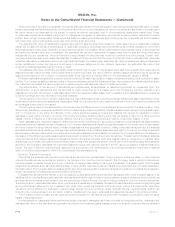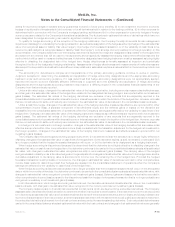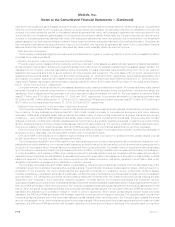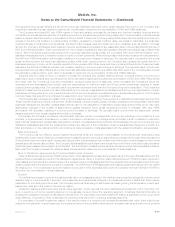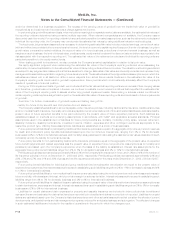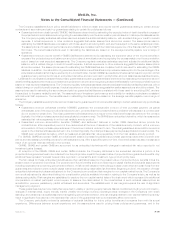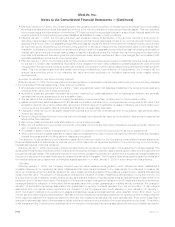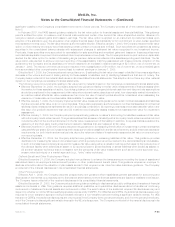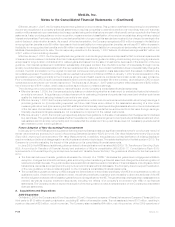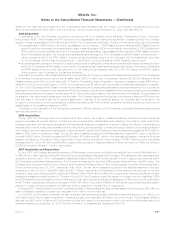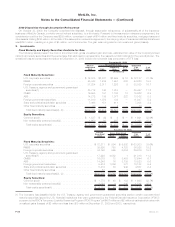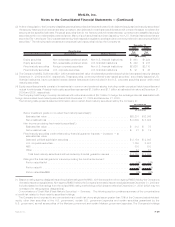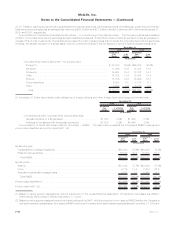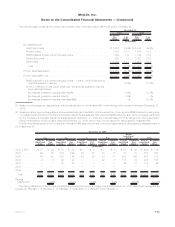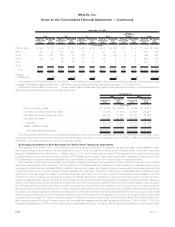MetLife 2009 Annual Report Download - page 108
Download and view the complete annual report
Please find page 108 of the 2009 MetLife annual report below. You can navigate through the pages in the report by either clicking on the pages listed below, or by using the keyword search tool below to find specific information within the annual report.• Effective December 31, 2008, the Company adopted new guidance on the recognition of interest income and impairment on purchased
beneficial interests and beneficial interests that continue to be held by a transferor in securitized financial assets. This new guidance
more closely aligns the determination of whether an OTTI has occurred for a beneficial interest in a securitized financial asset with the
original guidance for fixed maturity securities classified as available-for-sale or held-to-maturity.
• Effective January 1, 2008, the Company adopted new guidance relating to application of the shortcut method of accounting for
derivative instruments and hedging activities. This guidance permits interest rate swaps to have a non-zero fair value at inception when
applying the shortcut method of assessing hedge effectiveness as long as the difference between the transaction price (zero) and the
fair value (exit price), as defined by current accounting guidance on fair value measurements, is solely attributable to a bid-ask spread.
In addition, entities are not precluded from applying the shortcut method of assessing hedge effectiveness in a hedging relationship of
interest rate risk involving an interest bearing asset or liability in situations where the hedged item is not recognized for accounting
purposes until settlement date as long as the period between trade date and settlement date of the hedged item is consistent with
generally established conventions in the marketplace.
• Effective January 1, 2008, the Company adopted new guidance that permits a reporting entity to offset fair value amounts recognized
for the right to reclaim cash collateral (a receivable) or the obligation to return cash collateral (a payable) against fair value amounts
recognized for derivative instruments executed with the same counterparty under the same master netting arrangement that have been
offset. This new guidance also includes certain terminology modifications. Upon adoption of this guidance, the Company did not
change its accounting policy of not offsetting fair value amounts recognized for derivative instruments under master netting
arrangements.
Business Combinations and Noncontrolling Interests
Effective January 1, 2009, the Company adopted revised guidance on business combinations and accounting for noncontrolling interests
in the consolidated financial statements. Under this new guidance:
• All business combinations (whether full, partial or “step” acquisitions) result in all assets and liabilities of an acquired business being
recorded at fair value, with limited exceptions.
• Acquisition costs are generally expensed as incurred; restructuring costs associated with a business combination are generally
expensed as incurred subsequent to the acquisition date.
• The fair value of the purchase price, including the issuance of equity securities, is determined on the acquisition date.
• Assets acquired and liabilities assumed in a business combination that arise from contingencies are recognized at fair value if the
acquisition-date fair value can be reasonably determined. If the fair value is not estimable, an asset or liability is recorded if existence or
incurrence at the acquisition date is probable and its amount is reasonably estimable.
• Changes in deferred income tax asset valuation allowances and income tax uncertainties after the acquisition date generally affect
income tax expense.
• Noncontrolling interests (formerly known as “minority interests”) are valued at fair value at the acquisition date and are presented as
equity rather than liabilities.
• Net income (loss) includes amounts attributable to noncontrolling interests.
• When control is attained on previously noncontrolling interests, the previously held equity interests are remeasured at fair value and a
gain or loss is recognized.
• Purchases or sales of equity interests that do not result in a change in control are accounted for as equity transactions.
• When control is lost in a partial disposition, realized gains or losses are recorded on equity ownership sold and the remaining ownership
interest is remeasured and holding gains or losses are recognized.
The adoption of this guidance on a prospective basis did not have an impact on the Company’s consolidated financial statements.
Financial statements and disclosures for periods prior to 2009 reflect the retrospective application of the accounting for noncontrolling
interests as required under this guidance.
Effective January 1, 2009, the Company adopted prospectively new guidance on determination of the useful life of intangible assets. This
guidance amends the factors that should be considered in developing renewal or extension assumptions used to determine the useful life of a
recognized intangible asset. This change is intended to improve the consistency between the useful life of a recognized intangible asset and
the period of expected future cash flows used to measure the fair value of the asset. The Company determines useful lives and provides all of
the material disclosures prospectively on intangible assets acquired on or after January 1, 2009 in accordance with this guidance.
Fair Value
Effective January 1, 2008, the Company adopted new fair value measurements guidance which defines fair value, establishes a
consistent framework for measuring fair value, establishes a fair value hierarchy based on the observability of inputs used to measure fair
value, and requires enhanced disclosures about fair value measurements and applied this guidance prospectively to assets and liabilities
measured at fair value. The adoption of this guidance changed the valuation of certain freestanding derivatives by moving from a mid to bid
pricing convention as it relates to certain volatility inputs, as well as the addition of liquidity adjustments and adjustments for risks inherent in a
particular input or valuation technique. The adoption of this guidance also changed the valuation of the Company’s embedded derivatives,
most significantly the valuation of embedded derivatives associated with certain guarantees on variable annuity contracts. The change in
valuation of embedded derivatives associated with guarantees on annuity contracts resulted from the incorporation of risk margins
associated with non-capital market inputs and the inclusion of the Company’s own credit standing in their valuation. At January 1,
2008, the impact of adopting the guidance on assets and liabilities measured at estimated fair value was $30 million ($19 million, net of
income tax) and was recognized as a change in estimate in the accompanying consolidated statement of operations where it was presented
in the respective statement of operations caption to which the item measured at estimated fair value is presented. There were no significant
changes in estimated fair value of items measured at fair value and reflected in accumulated other comprehensive income (loss). The addition
of risk margins and the Company’s own credit spread in the valuation of embedded derivatives associated with annuity contracts may result in
F-24 MetLife, Inc.
MetLife, Inc.
Notes to the Consolidated Financial Statements — (Continued)


